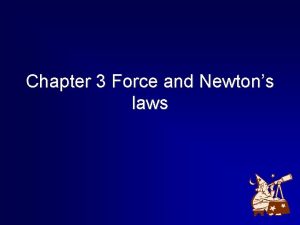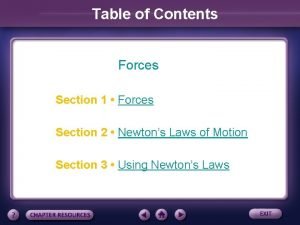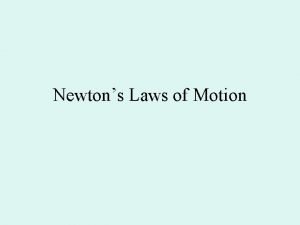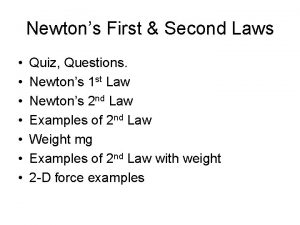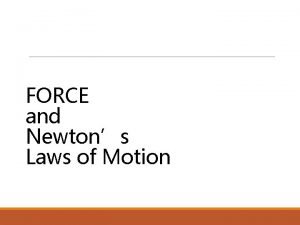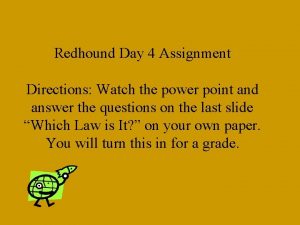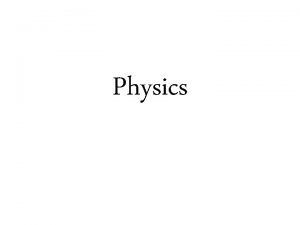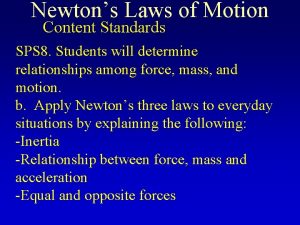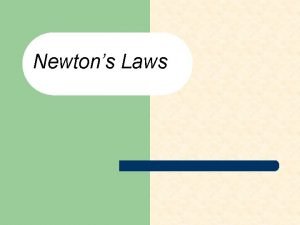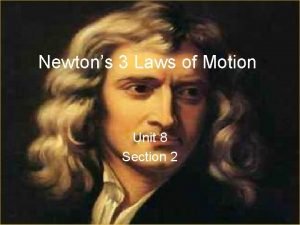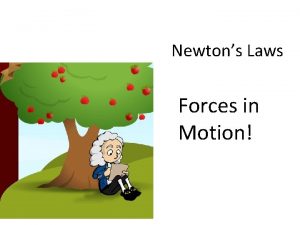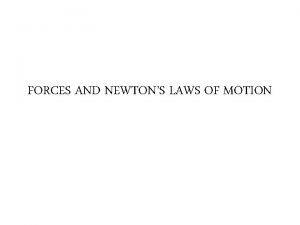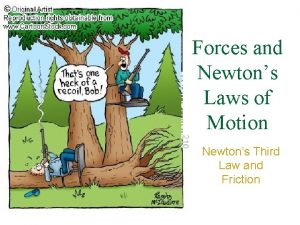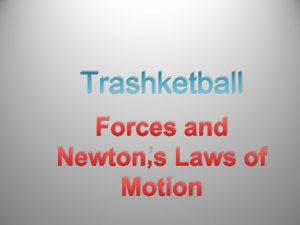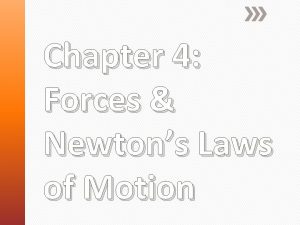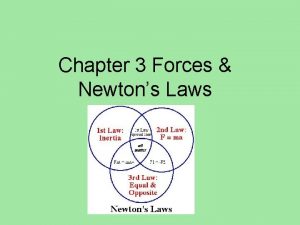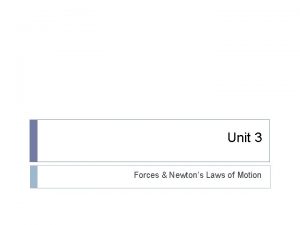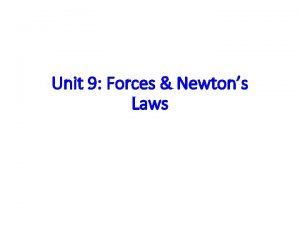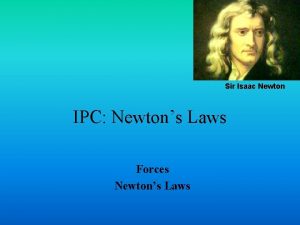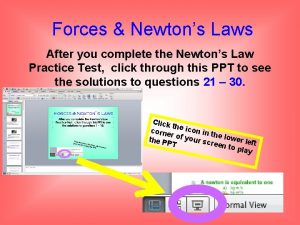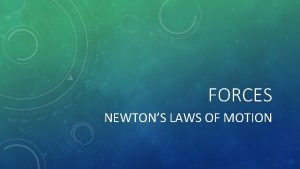Forces and Newtons Laws Chapter 3 Force Force




















- Slides: 20

Forces and Newton’s Laws Chapter 3

Force • Force is the cause of acceleration, or change in an object’s motion. (Push or a Pull) • Examples -Throwing or catching a ball, pushing a cart, pulling a cart • Formula Force = Mass (kg) x Acceleration (m/s 2) • Unit for Force is a Newton (N).

Friction – Type of Force Friction is the force between two objects touching that opposes the forward motion of the object. What type of surface creates more or less Friction?

Air Resistance/Friction – Type of Force Air Resistance- is a type of friction between air particles and an object. The amount of air resistance depends on size, shape and speed. How has the design of old vs new vehicles changed and why?

Gravity- A Type of Force Gravity- an attractive force between two objects that depends on the masses of the objects and the distance between them. Gravity depends on Mass and Distance

Weight - Type of force • Weight is the gravitational force exerted on an object. F = m x a to solve for your downward force • Convert your mass 150 lbs into kg by dividing by 2. 2 kg so 150/2. 2 = 68. 18 kg • Use the acceleration due to gravity 9. 8 m/s 2 for acceleration • F = 68. 18 kg x 9. 8 m/s 2 = 668. 16 N • As you can see weight is different than mass because weight takes into account that you have gravity (9. 8 m/s 2) pulling you down. • Solve for your Weight/downward Force

Net Force – Weight, Gravity and Friction acting on object’s motion Net force - the combination of all forces acting on an object. (weight, friction, gravity) These forces will determine whether the velocity of the object will change. (or whether the object will move) Label the forces not pictured

Unbalanced Force Unbalance fore- forces acting on an object that combine to produce a net force that is not zero. (a force that causes an object to move) Pusher #1 = 20 N and Puller #1 = 10 N Both force is same direction so add both together. 20 N + 10 N = 30 N going to the right

Examples of Unbalanced Forces 50 N & 40 N = 10 N Opposite direction - subtract Same direction - add

Balanced Force 30 N pushing to left and 30 N pushing to right, forces are in opposite direction so subtract 30 N - 30 N = 0 N (no motion) Balanced Force - forces on an object that combine to produce a net force of zero Balanced force equals no movement

Examples of Balanced Forces 20 N - 20 N =0 N 5 N - 5 =0 N NO MOVEMENT = BALANCED

Newton’s Laws of Motion Chapter 3 Section 2

Newton’s Laws of Motion • 1 st Law or Law of Inertia • An objects motion remains unchanged unless an outside force acts upon it. • An object in motion remains in motion or an object at rest remains at rest unless acted upon by an outside force.

1 st Law, Inertia Examples

Newton’s Laws of Motion • 2 nd Law or F=mxa • An objects motion is changed by a Force (N) which is equal to Mass (kg) x Acceleration (m/s 2) • So Force = Mass x Acceleration or • F = m x a • Triangle • If an object is falling due to Gravity then use a=9. 8 m/s 2

2 nd Law, F=m x a Examples F = 1, 000 kg x. 05 m/s 2 = 50 N

#1 F = m x a What is the net force necessary for a 1600 kg automobile to accelerate forward at 2. 0 m/s 2? Data Formula Work Ans F= F=m x a m= a=

#2 F=mxa 2. A baseball accelerates downward at 9. 8 m/s 2, if the ball has a mass of. 14 kg how much force was applied to the ball? Data Formula Work Ans F= m= a=

Newton’s Laws of Motion • 3 rd Law of Motion, Action Reaction Law • An objects motion is changed by a force which causes an action reaction • For every action there is an equal and opposite reaction.

Newton’s 3 rd Law, Action Reaction Law Examples
 Newton's law
Newton's law Newtons laws of gravity
Newtons laws of gravity Newtons 3 laws
Newtons 3 laws Third law of newton
Third law of newton Section 3 using newtons laws
Section 3 using newtons laws Section 1 forces
Section 1 forces Section 3 using newtons laws
Section 3 using newtons laws Newtons laws od motion
Newtons laws od motion What does f=ma mean
What does f=ma mean Newtons third lw
Newtons third lw Newton's first and second law quiz
Newton's first and second law quiz Newtons laws definitions
Newtons laws definitions Newtons three law
Newtons three law Vector diagram
Vector diagram Newtons 3 laws of motion
Newtons 3 laws of motion Newton all law
Newton all law Examples of law of inertia
Examples of law of inertia Newtons 3 laws
Newtons 3 laws Second law of motion examples
Second law of motion examples 3 law of motion
3 law of motion Newton's law
Newton's law




